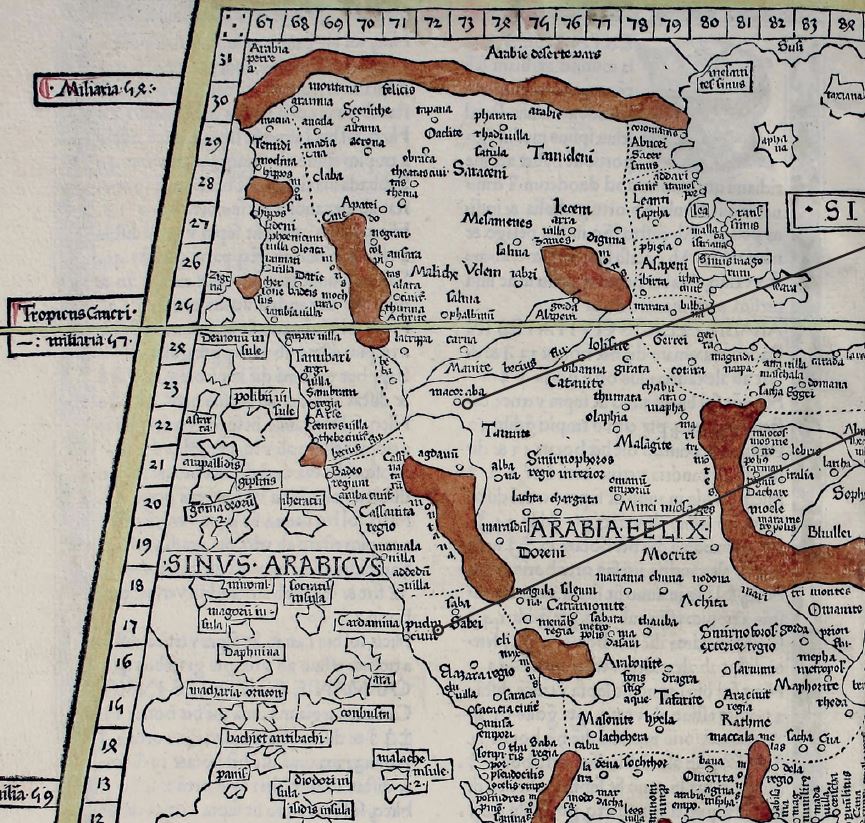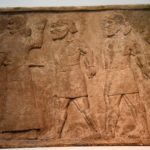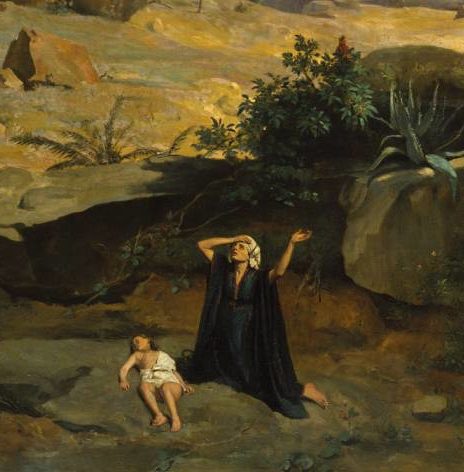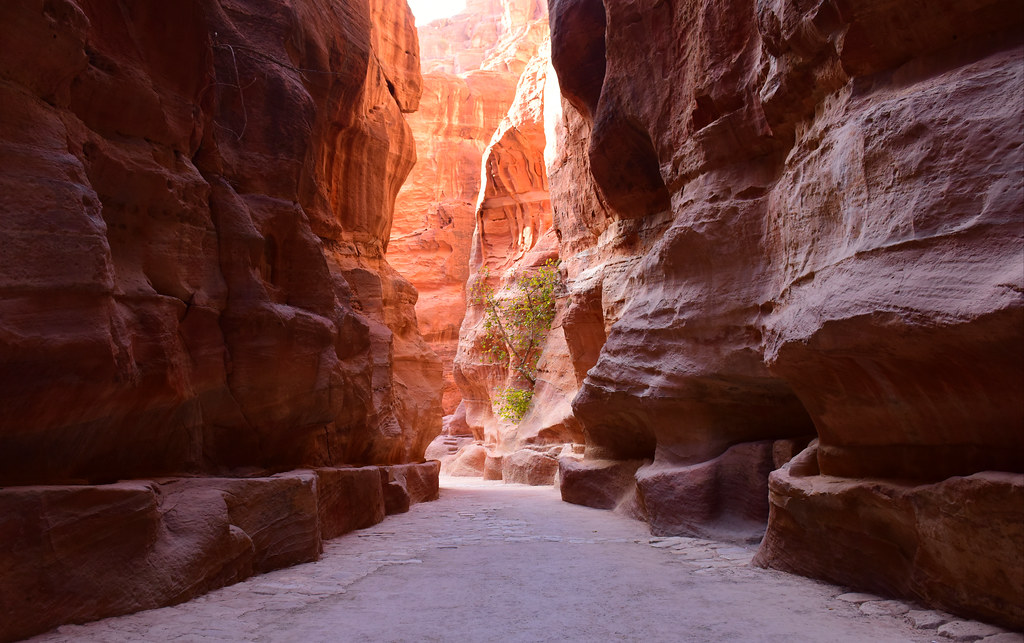
Makka, in its historical status and its trade, derives its importance from Muslim belief that it is one of the oldest cities on earth and that God commanded Ibrāhīm al-Khalīl (said to have lived around 1800 BC) to build a house there, which would be the first house on earth in which God would be worshipped.
SOME PROPONENTS of Qur’ānic miracles have imbibed this illusion and claimed that Makka indeed stands at the centre of the earth.[1] Some have even claimed that when astronauts reached the moon and looked back at the earth, they saw a dazzling spot of light, which later became clear to them as being Makka, and that the light was emanating from the Kaʽba.
Al-Ṭabarī says in his history:
Then God Almighty commanded Ibrāhīm, after Ismāʽīl and Isḥāq were born to him, as has been related, to build a house for Him in which He would be worshipped and recalled. Ibrāhīm did not know where to build this because this was not explained to him and was frustrated by this. Some scholars relate that God then sent down to him the Sakīna[2] to show him where the house should be. The Sakīna approached him while he was with his wife Hajar and his son Ismāʽīl who was still a small child at the time. Some, however, say that God sent down Jibrā’īl to indicate the site and show him what to do.
Hanād ibn al-Sarī reports that ‘Abu al-Ahwas told us on the authority of Sammāk ibn Ḥarb on the authority of Khālid ibn ‘Arʽara that a man stood before ‘Alī ibn Abī Ṭālib and said, “Will you not tell me about the house, for it is the first house ever built in the world?” He replied: “Nay, but it was the first house to be placed at Baraka, the place of Ibrāhīm, and whoever entered it was safe. If you wish, I will tell you how it was built. God Almighty revealed to Ibrāhīm: “Build a house for me on earth”. But Ibrāhīm became frustrated with that task, so God sent down the Sakīna – which is the wind of Khajūj and which has two heads. Now the one followed the other until it stopped at Makka and wrapped itself like a snake over the site for the house, and Ibrāhīm was commanded to build wherever the Sakīna rested. So Ibrahim built it there but a stone was still remaining to finish the work. As a boy set off to build something Ibrāhīm said: “Find me a stone as I command you!” So the boy went off to search for a stone for him and found that the Black Stone had been installed in its place. He said: “Who brought you this stone?” He replied: “One who was not commanded to your building – it was Jibrā’īl from heaven who brought it me, and who finished it.”[3]
The story, as it appeared in the Old Testament, is that Abraham, after he returned from Egypt with his wife Sarah settled in the Beersheba region. After his maidservant Hagar gave birth to his son Ishmael, he took Hagar and her child Ishmael on a donkey and left them with a waterskin somewhere in the region and returned to Sarah. The area of Beersheba is located near the Gulf of Aqaba, so it is inconceivable that Abraham and Sarah could have walked from Beersheba to Makka, a distance of no less than seven hundred kilometers, in order to build the Kaʽba there. The Hebrew references do not mention anything about Abraham going to Makka.
Was Makka really well-known, with a trading centre and caravans, as the narrators claim?
And it is strange that in order to build His holy house to be worshipped in God should chose a point in the desert of the Arabian Peninsula that has no water, no grass, and no inhabitants. The Qur’ān says through the voice of Ibrāhīm:
Our Lord! Lo! I have settled some of my posterity in an uncultivable valley near unto Thy holy House, our Lord! that they may establish proper worship; so incline some hearts of men that they may yearn toward them, and provide Thou them with fruits in order that they may be thankful.[4]
Ibrāhīm asks God to incline some hearts of men that they may yearn toward his family in Makka, which confirms that it was in a desert not inhabited by humans. So why would God choose such a place to build his house?
Makkah is located near the coast of the Red Sea in the southern part of the Arabian Peninsula, near the city of Jeddah. To the right of it runs the Hijaz mountain range while Yathrib, a large oasis inhabited by the ‘Aws and Khazraj tribes and some Jewish tribes, is located to the northeast of Makka in the plains of Hijaz. The distance between them is about 450 kilometers. Al-‘Aws and Al-Khazraj are tribes that migrated from Yemen to the north of the Arabian Peninsula. These tribes chose to live in Yathrib, after passing through the current location of Makka without residing there because it is a barren desert not inhabited by anyone. They chose Yathrib due to the presence of water and cultivation.
Trade routes from Yemen used to pass through the plains on the right of the Hijaz mountains due to the difficulty of driving camels over the mountains while laden with merchandise. These caravans passed through Ṭā’if or the oasis of Yathrib, where the caravan rests and resupplies with water and food before continuing on to the Levant, passing through Petra, which was an important commercial capital.
Was Makka really well-known, with a trading centre and caravans, as the narrators claim?
In fact, the current Makka did not exist. If it did exist at all, then it was a small village no one cared about and geographers do not mention. The Iraqi historian Jawād ‘AlI notes:
The credit for the survival of Makka and the survival of its inhabitants is due to its geographical location, as it is a nodal point at which caravans comng from southern Arabia to the Levant, or from the Levant making for southern Arabia, gather. It was necessary to pause at this place for men to shake off the dust of travel, and stock up on the provisions it offered. Its inhabitants soon discovered from these caravan travellers the secret of travelling and its benefits, so they themselves traveled in caravans, taking charge of trade excursions to the Makkans and other merchants from Yemen and the Levant. By the sixth century A.D. the merchants of Makka had monopolized trade in Western Arabia, and controlled transportation on the important roads linking Yemen with the Levant and Iraq.[5]
Dr. Jawād ‘AlI may have gleaned this information from heritage books, but we know for a fact from Himyarite carvings that the Himyarite kingdom invaded northwest and central Arabia and captured the Hijaz, Najd and Al-Aḥsā. Yemen has been known since ancient times for its trade in incense and myrrh, which was mentioned in the Old Testament. The Himyarites controlled the caravan trade from Hadramaut to the Levant, Palestine and Egypt, and they made mention even of the small oases they traded with, such as Ṭā’if. But they did not once mention Makka in their writings or inscriptions.[6] Greek, Roman and other historians also spoke of Yathrib, but they never spoke of Makka. On this, the well-known author Patricia Crone has this to say:
The Greek trade documents tell us about Taif, Yathrib and Khaybar, but they fail to mention Makka even once.[7]
From the second century BC until its fall to the Romans in 106 AD the Nabataean Empire had occupied northwest Arabia and Palestine and monopolized the caravan routes to the Levant and Palestine. It has left us detailed carvings and manuscripts of its kings and its trade with Palestine, Gaza and Syria. These manuscripts and carvings on stones mention several cities in the Arabian Peninsula and in Syria and Iraq, but they do not once mention Makka.[8] The name ‘Makka’ was not mentioned in the text of King Nabonidus of Babylon, a text in which the king listed the names of the places that submitted to his armies. His authority reached to the Hijaz, and ‘Yathrib’, according to the text, was the furthest place his rule reached in Western Arabia. To date we have not been able to find the name ‘Makka’ in any pre-Islamic writings.
It is most likely that the writer of the Qur’ān borrowed the name ‘Bakka’ from the Old Testament
As for historical resources written in non-Arabic languages, one work includes the name of a city called ‘Macoraba’. This book is the Geography of the well-known Greek scholar Ptolemy, who lived in the second century AD. Researchers have gone so far as to state that this town is ‘Makka’. If this is true, this would make Ptolemy the first to make any mention of it.[9]
Even if it is true that Macoraba means Makka, it was mentioned by Ptolemy in the second century AD, meaning that Ibrāhīm, who lived around 1800 BC, had not built the Ka’ba as they claim, otherwise Makka would have been very famous as the oldest city in the Arabian Peninsula. The Greek historian Diodorus Siculus (90-30 BC) also made no mention of ‘Makka’ in his monumental Universal History.
Nor did the historian Procopius of Caesarea (500-564 AD) mention Makka in his extensive work on the history of wars in the Arabian Peninsula. He lived in Palestine and knew the geography of the peninsula well.[10] It is known that the Eastern Roman Empire in Constantinople had recruited Arabs from the Hijaz and the Sinai desert to protect its western borders. The Roman Empire left a large amount of manuscripts mentioning the names of the Arab tribes that cooperated with them and the names of cities and places that were subject to those tribes. Yet researchers have failed to find in those manuscripts any mention of a city called Makka.
The Qur’ān mentions ‘Bakka’ and says the following:
Most surely the first house appointed for men is the one at Bakka, blessed and a guidance for the nations.[11]
There is no reason for the Qur’ān to say ‘Bakka’ if the city already existed and was called Makka. It is most likely that the writer of the Qur’ān borrowed this name from the Old Testament, which mentions The Valley of Weeping, in the Petra region in Jordan, in the psalms that say:
Happy is the man whose strength is in Thee; in whose heart are the highways. Passing through the valley of Bacha they make it a place of springs.[12]
Historians believe that the reason for naming the valley known in Petra as The Valley of Weeping is the destruction of the city due to the earthquake that destroyed it on May 19, 363 AD.[13] Historians did not find any mention of Makka before the year 740 AD, when it appeared in the Continuatio Byzantina Arabica. The first map showing the name of Makka dates back to the year 900 AD.[14]

Suggested Reading
Bahrain was the most important trading centre in Arabia. It is said that around the years 2,300 BC Sargon of Akkad seized control of Bahrain and Qatar, and that Bahrain at about 1,750 BC was in the hands of a tribe called ‘Agarum’. This name is close to the term ‘Ajram’ which was paying tribute to King Esarhaddon. Some researchers have argued that the Agarum are the people of the city Hajar, which is Al-Aḥsā. Commercial relations have always been continuous between Bahrain and Iraq. ‘Dilmun’ (which is Bahrain) was a very important station for trade between India, Africa, the Gulf coasts and Iraq. Timber was imported from India and from Africa as well as crops while copper was trafficked from Oman to be sold in southern Iraq. This trade may have been carried by ships owned by the people of ‘Ur’ or others, via the Euphrates River, to be transported from there to the Levant, and thence to the Mediterranean to sell it to the people of Greece and the rest of Europe.
It is clear from accounts dating back to the days of the Second Dynasty of the families of Ur that ships of that time (2200-2100 BC) were making regular trips between Bahrain and Ur, in order to transport copper and precious stones from Oman, and gold, timber and other valuable materials from India.[15] The island of Bahrain was commercially important, and therefore manuscripts of all cultures at the time duly made mention of it. But those manuscripts did not mention Makka at all, since if Makka had existed at that date, then it definitely had no agriculture or industry to export it to other cities. It is therefore inconceivable that it was an important enough commercial city for commercial convoys to make a stop there.
[1] See, for example the article مكة هي مركز الكرة الأرضية at https://ar.islamway.net/article/54 .
[2] Sakīna is traditionally understood to mean ‘the spirit of tranquility, or peace of reassurance’, or ‘indwelling’ and scholars have postulated that the term seems to be related to the Hebrew Shekhinah (שכינה), the term for God’s presence in the world. (Ed.)
[3] Al-Ṭabarī, تاريخ الأمم والملوك Vol. 1, p.152.
[4] Qur’ān XIV (Ibrāhīm), 37.
[5] Jawād ‘Alī, المفصل في تاريخ العرب قبل الإسلام Vol. 2, p.400.
[6] Peter Townsend, The Makka Mystery: Probing the Black Hole at the Heart of Muslim History.
[7] Patricia Crone and M.A.Cook, Hagarism: The Making Of The Islamic World, Cambridge University Press,1976, p.22
[8] Dan Gibson, Quranic Geography, Independent Scholars Press, Canada, 2011, 154-67, quoted in Peter Townsend, The Makka Mystery.
[9] Jawād ‘Alī, ، المفصل في تاريخ العرب قبل الإسلام Vol. 2, p.401.
[10] Procopius and Henry Bronson, History of the Wars, 1-2, Cambridge, London: Harvard University Press, 2006, pp.179-195. From Peter Townsend, The Makka Mystery.
[11] Qur’ān (Āl ‘Imrān), 96.
[12] Psalms LXXXIV, 6-7: אַשְׁרֵי אָדָם, עוֹז-לוֹ בָךְ; מְסִלּוֹת, בִּלְבָבָם עֹבְרֵי, בְּעֵמֶק הַבָּכָא– מַעְיָן יְשִׁיתוּהוּ The word בָּכָא bakhā means ‘weeping’ (cognate with the Arabic بكاء bukā’ with the same meaning) and the phrase is commonly translated ‘The Valley of Tears’. (Ed.)
[13] Dan Gibson, Quranic Geography, p.18. View this book in the Almuslih Library here.
[14] Dan Gibson, Op. cit., p.224.
[15] Jawād ‘Alī, ، المفصل في تاريخ العرب قبل الإسلام Vol. 1, p.187.
Main image: Macoraba in Ptolemy’s map from his Cosmographia. Macoraba is sited where the upper line points, with the actual site of Makka sited where the lower line points. Woodprint from a rare edition of the Cosmographia dating from 1482 printed at Ulm, drawn by Donnus Nicolaus Germanus (1420-1490).


